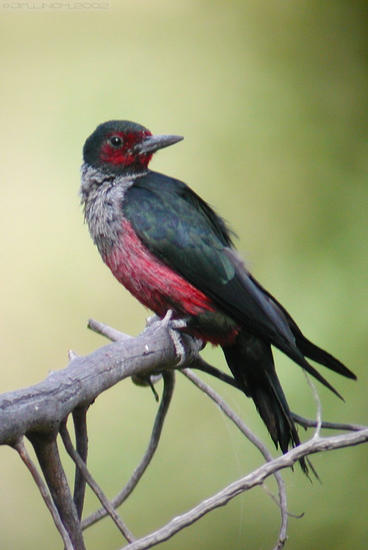Nomdeploom (talk | contribs) m (add genus tag) |
m (→External Links) |
||
| (4 intermediate revisions by 2 users not shown) | |||
| Line 1: | Line 1: | ||
| + | [[Image:Lewiss_Woodpecker.jpg|thumb|450px|right|Photo © by {{user|day5creations|day5creations}}<!--EDITORS: there is no location/date information supplied on picture-->]] | ||
;[[:Category:Melanerpes|Melanerpes]] lewis | ;[[:Category:Melanerpes|Melanerpes]] lewis | ||
| − | |||
| − | |||
==Identification== | ==Identification== | ||
| − | + | 26–29 cm (10¼-11½ in) <br /> | |
| − | + | *Metallic greenish black upperparts | |
| + | *Grey collar and breast | ||
| + | *Pinkish-red belly | ||
| + | *Dark red face framed with greenish black<br /> | ||
| + | Sexes Similar | ||
==Distribution== | ==Distribution== | ||
| − | Most of the western United States west of the Dakotas, except rare in the coast states. | + | [[Image:1268Lewis s fledge-2004.jpg|thumb|300px|right|Fledgling (note lack of red on face and just the first blush of color on breast)<br />Photo © by {{user|Katy+Penland|Katy Penland}}<br />Overgaard, [[Arizona]] yard, July 2004]] |
| + | Most of the western United States west of the Dakotas, except rare in the coast states.<br /> | ||
| + | Rare vagrant to the plains states.<br /> | ||
| + | Casual vagrant to the northeast. | ||
==Taxonomy== | ==Taxonomy== | ||
| − | + | This is a [[Dictionary_M-S#M|monotypic]] species<sup>[[#References|[1]]]</sup>. | |
==Habitat== | ==Habitat== | ||
Open pine-oak woodlands, oak or cottonwood groves in grasslands, ponderosa pine country. | Open pine-oak woodlands, oak or cottonwood groves in grasslands, ponderosa pine country. | ||
==Behaviour== | ==Behaviour== | ||
| − | + | ====Breeding==== | |
| + | They lay 6-8 white eggs in a cavity in a dead stump or tree limb, often at quite a height. The male makes the nest and both parents incubate for 12 days. They nest in loose colonies. | ||
| + | ====Diet==== | ||
| + | Their main diet consists of flying insects in a similar way to the [[Acorn Woodpecker]]. They also store acorns and other nuts for winter, and sometimes damage fruit orchards. | ||
| + | ====Vocalisation==== | ||
| + | [[Image:Arastradero 2008-01-191.jpg|thumb|350px|right|Photo © by {{user|djleahy|djleahy}}<br />Arastradero Open Space Preserve, Palo Alto, [[California]], January 2008]] | ||
| + | They are generally silent, but they occasionally give a low churring note. | ||
| + | ====Action==== | ||
| + | Flight is crow-like, not undulating. | ||
| + | ==References== | ||
| + | #{{Ref-Clements6thAug18}}#National Geographic | ||
| + | #Handbook of the Birds of the World Alive (retrieved August 2017) | ||
| + | {{ref}} | ||
| + | ==External Links== | ||
| + | {{GSearch|"Melanerpes lewis" {{!}} "Lewis Woodpecker"}} | ||
| + | {{GS-checked}}1 | ||
| + | <br /> | ||
| + | <br /> | ||
| − | |||
| − | |||
| − | |||
| − | |||
[[Category:Birds]] [[Category:Melanerpes]] | [[Category:Birds]] [[Category:Melanerpes]] | ||
Latest revision as of 21:57, 9 February 2023

- Melanerpes lewis
Identification
26–29 cm (10¼-11½ in)
- Metallic greenish black upperparts
- Grey collar and breast
- Pinkish-red belly
- Dark red face framed with greenish black
Sexes Similar
Distribution

Photo © by Katy Penland
Overgaard, Arizona yard, July 2004
Most of the western United States west of the Dakotas, except rare in the coast states.
Rare vagrant to the plains states.
Casual vagrant to the northeast.
Taxonomy
This is a monotypic species[1].
Habitat
Open pine-oak woodlands, oak or cottonwood groves in grasslands, ponderosa pine country.
Behaviour
Breeding
They lay 6-8 white eggs in a cavity in a dead stump or tree limb, often at quite a height. The male makes the nest and both parents incubate for 12 days. They nest in loose colonies.
Diet
Their main diet consists of flying insects in a similar way to the Acorn Woodpecker. They also store acorns and other nuts for winter, and sometimes damage fruit orchards.
Vocalisation
They are generally silent, but they occasionally give a low churring note.
Action
Flight is crow-like, not undulating.
References
- Clements, J. F., T. S. Schulenberg, M. J. Iliff, D. Roberson, T. A. Fredericks, B. L. Sullivan, and C. L. Wood. 2018. The eBird/Clements checklist of birds of the world: v2018. Downloaded from http://www.birds.cornell.edu/clementschecklist/download/
- National Geographic
- Handbook of the Birds of the World Alive (retrieved August 2017)
Recommended Citation
- BirdForum Opus contributors. (2024) Lewis's Woodpecker. In: BirdForum, the forum for wild birds and birding. Retrieved 27 May 2024 from https://www.birdforum.net/opus/Lewis%27s_Woodpecker
External Links
GSearch checked for 2020 platform.1




